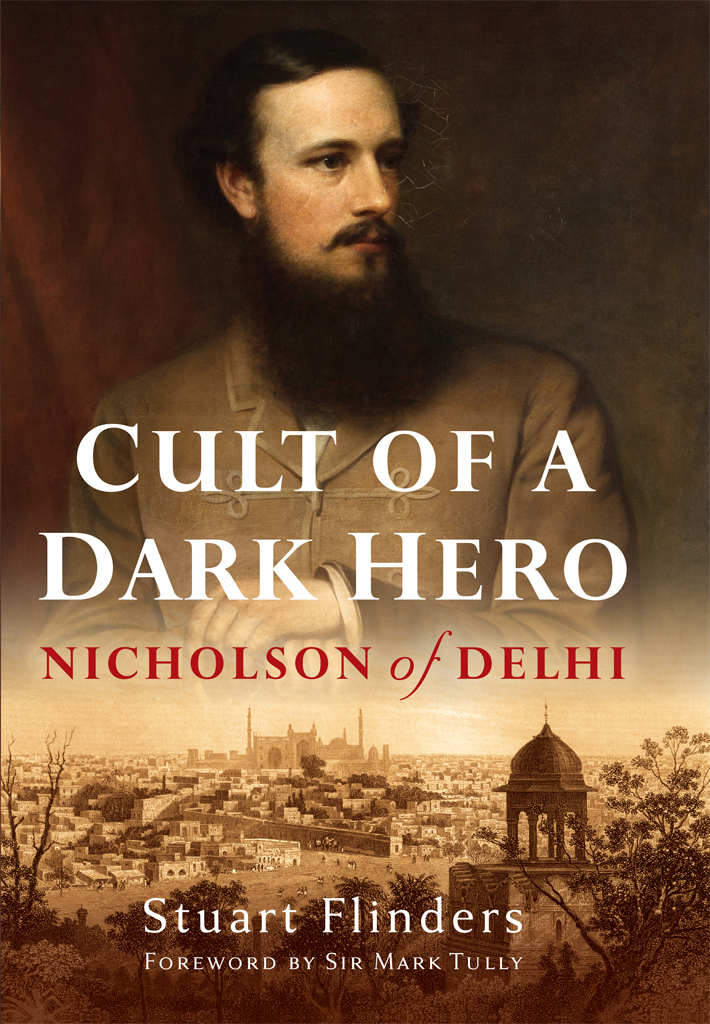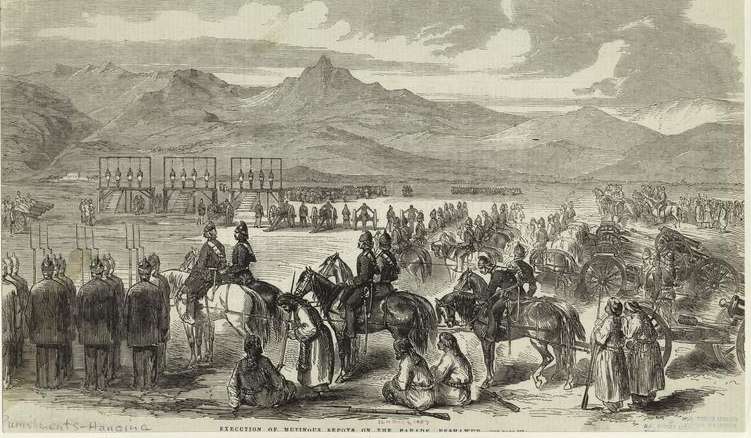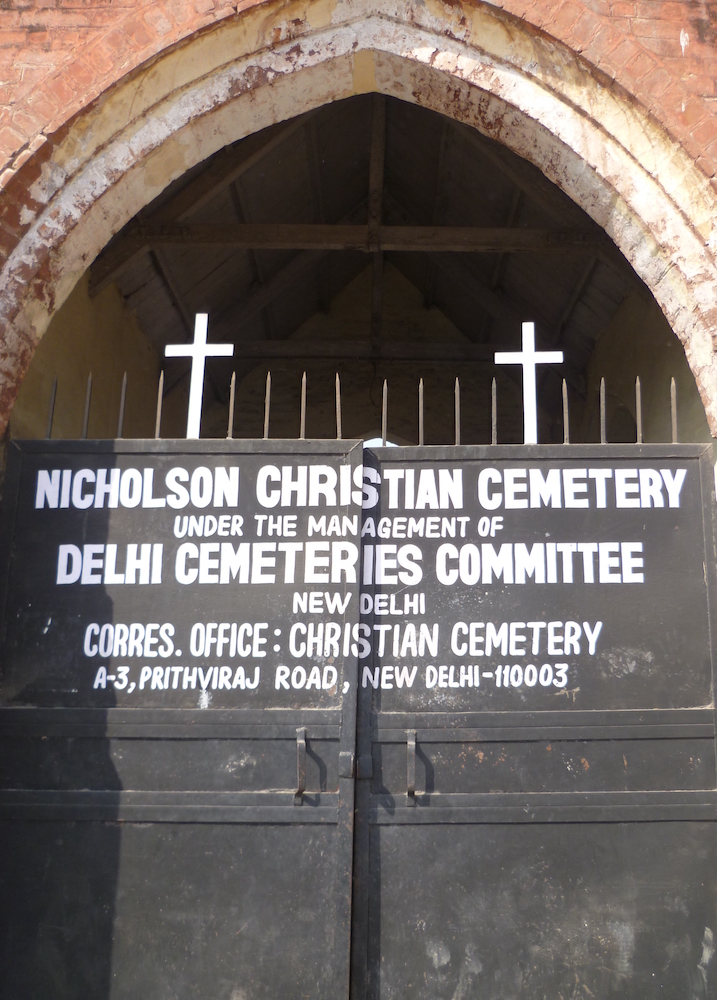[Apart from the first and last images, this review is illustrated from our own website. Please click on the images to enlarge them and for more information about them.]

tuart Flinders tells the troubling story of John Nicholson (1822-1857), one of the most colourful — and probably also one of the most brutal — military figures of the Victorian age, who acquired nothing short of a cult following for his spirited soldiering in the sub-continent. The problem is, how do we judge him now, in an age of postcolonial angst? Flinders himself is ambivalent, and most readers will understand why, and perhaps form a harsher judgement.

Cover of the book under review.
Nicholson's background was not at all military, but it did have an Indian connection. His father Alexander was a doctor, who qualified in Dublin, and then married the daughter of a wealthy merchant in Lisburn, County Antrim, on the outskirts of Belfast. This is where India starts to come in: one of his wife Clara's brothers, James Weir Hogg, had been a lawyer in Calcutta (incidentally, his son Quintin Hogg was the founder of the Regent Street Polytechnic in London); James himself would twice serve as Chairman of the East India Company. Unfortunately, Dr Nicholson died young in 1830, leaving Clara and their seven children to rely on the support of relatives in Lisburn. Here John, who was born in 1821, had his elementary education, entering the Royal Grammar School in Dungannon for his secondary education at the age of eleven. He was a complicated lad, close to his mother, but apparently a spendthrift, who found it hard to live within his means. Clara had to remind him of “the financial difficulties caused by his father's early death,” telling him on one occasion, “I will for this time, give the money you require. In future you must be content with your weekly allowance. What other boys have or do, cannot be rule for you who are the son of a widow, with five boys to educate” (7). Worse, his elder sister recalled in her old age that John was “just a great big bully" (7).
Not having distinguished himself at school, Nicholson had no qualification for a job in Ireland, and his mother thought that he might try his luck abroad. She asked her brother whether he could help. Hogg duly obtained a cadetship for his nephew in the Bengal Infantry. It must have been a wrench for a youth still in his teens and apparently still close to his mother. Her parting advice to him was a bracing instruction: “Never forget to read your Bible” (8).
By now, of course, the East India Company was no longer just a trading company. It had developed those political motives that turned it into an organisation with imperialistic ambitions. As the Mughal rule declined the power of the East India Company grew: it tried to control the smaller kingdoms in the country, and for this purpose enlarged its own army, which consisted mainly of Indian sepoys led by British officers. Since it was still a private trading company, it did not have the seal of a country, and was able to make its own rules for entry, promotion or demotion. This was the situation when Nicholson came to India, and Flinders shows how well it worked to his advantage. On his arrival in July 1839, the lad was commissioned as an ensign in the 27th native infantry at Ferozpur: during the Mutiny the militarily unqualified young man, still in his thirties, would rise to the height of Brigadier General in consequence of not only his bravery but also his ruthless slaughtering of the mutinous sepoys.
Initially, however, Nicholson went through the difficulty of adjusting to a new country. Having come from Ireland with its cool climate, he had to get used to the fierce Indian heat, which naturally came as “something of a shock" to him (10). But he soon settled down. At that time the Company's forces were were made up of about 37,000 British soldiers and about 200,000 native troops. Though Nicholson had no military education or training, he quickly learned the trade. Despite having come from a relatively poor country himself, he felt superior to the Indians whom he felt he was required to rule. Unfortunately this brought out what seems now to have been an alarmingly strong streak of savagery. Flinders can give no explanation for this side of him, except for some unsupported speculation that it was sexual in origin. In particular, some have thought he was suffering from repressed homosexuality: Flinders quotes Christopher Hibbert, for instance, as saying, "he seems to have been tortured by homosexual desires that shamed and horrified him" (183). But no direct evidence of such desires has been found.

Brigadier General John Nicholson, by Sir Thomas Brock, unveiled in New Delhi in 1906, now at Dungannon School. He is said to have looked older than his years.
Of his courage, resolution and decisiveness, there is no question. One of Nicholson's first appointments was in the army in Afghanistan. With his fellow-men, he was moved to cities like Jalalabad, Ghazni and Kabul, where fighting was extraordinarily fierce. Nicholson said of the Afghans that they were, “without exception the most bloodthirsty and treacherous race in existence” (18). These battles remained memorable for him. They would, says Flinders, "leave him with lasting hatred of Afghans” (9). Perhaps it was this period, in fact, that accounts for his savage behaviour. He certainly acted cruelly. Once he arrived at lunch late because, as he told his guests, he had paused to hang the cooks who, he suspected, were planning to poison him! In the event, the Afghans proved to be the superior fighters. However, they allowed the British to withdraw unmolested into the Indian territory of the Punjab.
Nicholson's rise through the ranks was rapid. After the return of the army to India, he was made adjutant of his regiment in 1845. Soon he was selected to instruct the troops of the Maharaja of Kashmir, Gulab Singh. Before long he left Kashmir, and in 1847 went to Multan. Because of his proven leadership qualities, when the Anglo-Sikh war started, Nicholson's services were deemed invaluable. In recognition of this, he was promoted to brevet major on 7 June 1949. From Kashmir, he was sent on a special mission to Amritsar in the Punjab. A rebellion had broken out there and he was sent to curb it. When the second Anglo-Sikh war started, Nicholson provided boats to Sir Joseph Thackwell in the hope that the mutineers would be beaten. Then he accompanied his General in pursuit of the Sikhs, and conquered them. On the annexation of the Punjab, Nicholson, still in his early thirties, was appointed commissioner of the Lahore board.
The rise of the East India Company is as extraordinary as Nicholson's. It was steadily taking over the smaller kingdoms around it, and levying taxes on the people. Naturally, this caused dissatisfaction among the them. An Indian Muslim poet Fakir Khair udDin Alahabadi said that even though the Mughal rule was declining, the people lived in peace. This was disturbed by the activities of the the army of the Company, and an early proof of the consequent disruption was in the army itself, in the major landmark rebellion of 1857. Nicholson's close friend Herbert Edwardes had said encouragingly, “when the Muhommedan [sic] and Hindoo have done their worst, the Christians will triumph unmistakeably and unexpectedly over them both” (115). But it was by no means a foregone conclusion.

Execution of mutinous Sepoys on the parade, Peshawur. 1857. New York Public Library image.
As the rebellion spread, Nicholson was already thinking in terms of the British Empire. Writing to John Lawrence (Sir Henry Lawrence's brother), he declared that the army's priority should be fighting the insurgents, rather than safeguarding their own families: after all, he said, “when an Empire is at stake, women and children cease to be of any consideration whatever” (117). His presence at Jullundur (now Jalandhar) in the Punjab was indicated by the appearance of gallows, where rebels were brought by bullock-carts to be hanged. At least one of his young officers found this hard to condone: "Such cruelties must tell against us in the long run," he said prophetically, "and because these men have done the same to us [...] is no reason that we should emulate them. Kill them by all means by hanging and shooting the really guilty [but the innocent should be spared]” (qtd. 117).

The Cashmere Bastion, Delhi. September 15, 1857, where Nicholson fell. He was mourned as a hero. In the background is St James's Church, wrongly identified in the Art Journal, where this engraving appears, as St Paul's.
Now, however, Nicholson was about to get a dose of his own treatment. He soon moved with his men to Delhi as this became the centre of the fighting. All the groups of the mutineers descended on the city: "it had become the focal point for the rebellion” (119). Cities like Cawnpore and Lucknow were under siege, and in early August Nicholson's friend and mentor Sir Henry Lawrence died in the latter. Nicholson in the meantime fought against the rebels, who grew in numbers. The roads were flooded and weather was atrocious. It became a challenge to move the tanks and equipment. None of this deterred Nicholson. He "appealed to his men in the name of God and the Queen to follow him and rushed on, his sword arm raised. At that moment he was shot” (148). It was at this juncture, then, that Nicholson was fatally wounded, in the very midst of the fighting. He was carried to Kabul Gate where he was seen by Captain Graydon who said, “I went across to him, found him in great suffering, and gave him some a little brandy, which evidently did him good. This was the last I saw of this gallant soldier” (149). Nicholson was asked to make his will, but when reminded about it after lingering on for several days, was physically incapable of doing so. Doctors and medical did all that they could, but he died on 23 September 1857 at 10.30 a.m.

Entrance to the Nicholson Cemetery in Delhi, where Nicholson is buried. Photograph by JB.
The account of his last days is dramatic and emotional, the more so because his brother Charles, fighting in the same conflict, had lost an arm, and for a while was in the same field hospital. But the title and subtitle of this book pretty much sum up Nicholson's life. A man from Ireland, he had shown immense bravery and also unthinkable cruelty, slaughtering the Indians who had risen in rebellion against a trading company's army. He was finally felled by a rebel's (or, as we would say now) a freedom fighter's bullet in Delhi. As a celebrated Brigadier-General, he was buried near where he had fallen, by the Kashmiri Gate in Delhi. Statues were erected in his memory, and, with the eventual ousting of the British Raj, one of those statues was taken to his school in Ireland, the Royal School in Dungannon, where one of its houses is named after him. He may still be remembered with pride by some, but history seems to be judging him more severely now.
Related Material
Book under Review
Flinders, Stuart. Cult of a Dark Hero: Nicholson of Delhi. London: I. B. Tauris, 2018. 231 + xix pp. £25.00 (hbk). ISBN 1-78831-236-3.
Created 18 September 2019